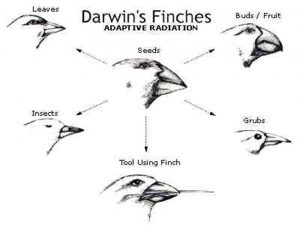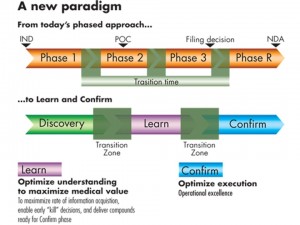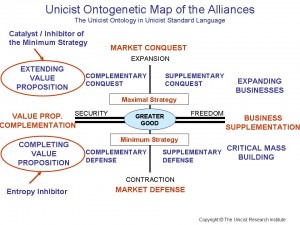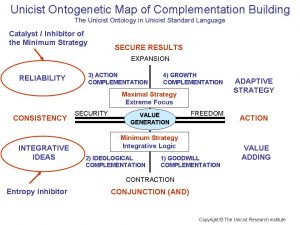
The 10-year Global Future Scenario of Objects driven Virtual Collaboration, developed by the Future Research Lab of The Unicist Research Institute and led by Peter Belohlavek, defines the trend towards this type of work organization when some of the following conditions are given:
- Extreme specialized solutions are needed
- There is a need for time saving
- There is a need for timing
- Transparency of work processes
- Reliability systems
- Customer orientation
- Quality assurance in work process
About Virtual Collaboration
The communication and IT technologies allowed making the next step in organizational design, integrating personal and virtual collaboration, organizing roles and using business objects, to maximize results and minimize costs.
This is a change in working habits that is extremely valuable to manage the adaptive aspects of businesses.
The virtual collaboration allows developing both internal and external work processes. The introduction of this technology needs to begin with the activity where the productivity increase is needed the most.
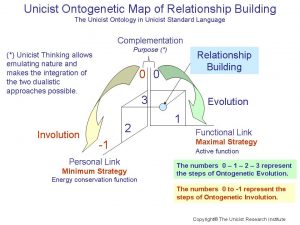 Marshall McLuhan said: “The Medium is the Message”. There is no doubt that virtual media are less powerful than in-person activities to build personal relationships. Therefore it is necessary to compensate this characteristic with an increase of functionality in the group dynamics.
Marshall McLuhan said: “The Medium is the Message”. There is no doubt that virtual media are less powerful than in-person activities to build personal relationships. Therefore it is necessary to compensate this characteristic with an increase of functionality in the group dynamics.
Functionality is increased by using business objects (that introduce functional adaptive automation into the processes). The use of business objects driven work processes allows increasing the functionality of virtual collaboration processes and building a context of simplicity.
In order to achieve group synergy, it is required that the group follows a protocol that establishes the rules of actions and the distribution of credits for its members.
It has to be considered that the bond established between the members of a group is basic to provide a collaboration context that allows achieving synergy and thus increases the productivity.
The fundamentals of this bond are given by the complementation between the members, the functionality of each role and the personal link between the members.
The drivers of this trend are:
- The use of virtual collaboration at a personal level on Internet
- The massification of the use of Internet
- The use of virtual collaboration by many leading organization such a: Shell, IBM, Deloitte, Google, Cisco, etc.
The new technologies that sustain this trend:
- Cloud computing
- Audio/Video-conferencing
- Data-sharing
- Desktop-sharing
- Web-conferencing
- Imaging technologies
- Object Driven Organization
- Adaptive IT Solutions
- Client Centered Management
Where will Virtual Collaboration be installed as a standard within the next 10 years?
- Project Management
- Work Process Monitoring
- Home Office
- Research & Development
- Counseling/Coaching/Tutoring
- Business consulting
- Auditing
- IT R&D
- Virtual Negotiations
- B2B Marketing
- Buying Processes
- Business Monitoring
- Customer Support
- Auditing
- Corporate Universities
- Medical Consultations
- Medical Prevention
- Medical Monitoring
- Clinical Trials
To access the basics on Unicist Future Research please enter: www.unicist.org/sdp.shtml
Subjectivism is the killer of Virtual Collaboration
Subjectivism at work is the prevalence of subjective, ungrounded opinions, which prevail over any foundations that can be installed by a counterpart. Subjectivism implies the need of using distortive perceptions, denial and fallacies to avoid dealing with the actual problems.
Subjectivism is necessarily driven by manipulation which necessarily requires an extreme use of emotional influence to avoid dealing with the functional aspects of reality.
http://unicist.net/economics/manipulation-is-a-long-term-business-killer/
Therefore virtual collaboration requires working in functional environments where the roles of individuals are recognized by the results they can produce and their capacity of teamwork. Subjectivists can use virtual communication but not virtual collaboration.
What is needed to deal with Virtual Collaboration?
There are three aspects of organizations that need to be considered when installing virtual collaboration as a standard:
- Client Centered Management, to organize towards the satisfaction of customers and clients.
- Object Driven Organization, to use objects and personal roles to introduce functional adaptiveness in the processes.
- Adaptive IT solutions in order to provide a framework to sustain the efficacy of the participants.
1) Client Centered Management (CCM)
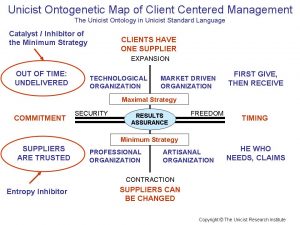 CCM is a management model that was developed to establish the rules for an optimum use of the company’s energy so as to satisfy its internal and external clients. When talking about the external client in the company we necessarily refer to the customer and the shareholder. CCM is a meta-model to provide result-assurance, client orientation and secure added value to an organization. It is the natural model to expand businesses.
CCM is a management model that was developed to establish the rules for an optimum use of the company’s energy so as to satisfy its internal and external clients. When talking about the external client in the company we necessarily refer to the customer and the shareholder. CCM is a meta-model to provide result-assurance, client orientation and secure added value to an organization. It is the natural model to expand businesses.
CCM is a paradigmatic adaptive system integrated by multiple business objects.
The core objects are:
1) The Unicist Reliability System
2) The Unicist Scorecard
3) The Unicist Quality Assurance System
The principles that integrate the CCM meta-model are:
1. Divide the processes into client-supplier units
This division aims at determining which operating units have a clear “output” so as to be suppliers and which have a clear “input” so as to be considered clients.
2. Minimize intermediaries
This principle follows the natural concept of “the larger the number of intermediaries, the bigger the entropy”.
3. Services or products received are paid for
This principle makes the organization become more aware of costs and benefits and enables negotiating goals to obtain measurable and predictable results.
Maximal Strategy
4. Each client has only one supplier
The principle that each client has only one supplier defines the role of the supplier which drives towards a solution driven approach and not only a task driven approach.
5. First giving, then receiving
It implies that services are paid for once rendered and not during the rendering process or in advance. There can be grounded exceptions to this in the organization.
6. Delivered out of time is considered undelivered
In practice, it ends up in an incentive system for each delivery on time and a punishment system if the dispatch is made out of time.
Minimum Strategy
7. Every client may change his supplier
The organization’s success is given by its capacity to satisfy the clients’ needs. This obliges the organization to manage the unfulfilled situations a supplier may have.
8. He who needs claims
“He who needs claims” is a principle based on the KANBAN approach which is closely associated with the natural tendency of satisfying one’s own needs.
9. Each supplier counts on his client’s trust
One of the basic principles of any successful large company is having a high reliability level. Reliability and trust are “sine qua non” principles for CCM’s application.
2) The Object Driven Organization
The unicist organizational approach is based on emulating nature in organizations. An extremely effective organization can be developed integrating both structural aspects that sustain evolution and incidental aspects that allow dealing with conjunctures. Emulating nature implies integrating the abstract apprehension of reality with the concrete operational design.
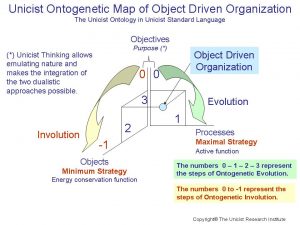 A unicist object driven organization is a result driven model that, according to the predefined objectives, designs the necessary processes and uses and reuses business objects to produce the expected results.
A unicist object driven organization is a result driven model that, according to the predefined objectives, designs the necessary processes and uses and reuses business objects to produce the expected results.
The object driven organization requires having a high level of maturity in business. It can be defined as the organization of processes and the use of objects to achieve the objectives that have been established in a strategy.
An object driven organization implies the development of a maximal strategy that includes the design of processes based on taxonomic procedures to put them into action and also a shared vision that makes these processes consistent with the business.
The vision of the organization is the catalyst of the minimum strategy. If it does not achieve its threshold, it works as an inhibitor of the minimum strategy and destroys the organization. The minimum strategy is based on the use and reuse of objects within the context of methodic procedures to ensure their use and functionality. This is sustained by an action plan (a “to do” list) to guarantee the fulfillment of the minimum strategy.
The use of business objects structures the timing and synchronicity of business processes. It also provides the necessary acceleration to achieve the needed critical mass and the required speed to adapt to the environment.
Types of Business Objects
There are five business objects which are: the drivers, the entropy inhibitors, the inhibitors, the catalysts and the gravitational objects.
 The first three ones belong to the process of a system while the catalysts are part of the restricted context and the gravitational objects belong to the wide context of a system.
The first three ones belong to the process of a system while the catalysts are part of the restricted context and the gravitational objects belong to the wide context of a system.
Objects can be designed integrating these three functions as part of their functionality or they can exist as three different objects to provide the driving, inhibiting and entropy inhibiting functions in a process.
Catalysts and gravitational objects are not part of the system. If one integrates them into the system, these objects do not work as such and destroy the system’s functionality.
The use of business objects requires individuals who understand the business processes in order to use the objects and replace them when their functionality has been exceeded
Unicist Business Objects are provided for the following uses:
- Driving Objects
To drive processes
- Catalyzing Objects
To accelerate processes
- Entropy Inhibiting Objects
To inhibit the entropy of business processes
- Inhibiting Objects
To inhibit dysfunctional events in a business
- Gravitational Objects
To influence the results of processes
3) Adaptive IT Solutions
The available IT technologies made the development of adaptive systems meaningful. The objective of building adaptive systems is to integrate software, hardware and peopleware in adaptive work or business processes to assure the quality of the results produced.
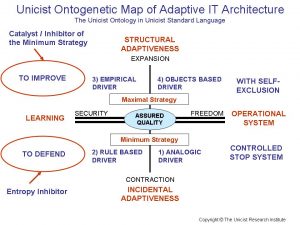 The development of the adaptive IT technology became possible because of the discovery of the unicist laws of evolution, the object driven organization that emulates the organization of nature and the drivers of human behavior that allow designing the necessary peopleware.
The development of the adaptive IT technology became possible because of the discovery of the unicist laws of evolution, the object driven organization that emulates the organization of nature and the drivers of human behavior that allow designing the necessary peopleware.
Before the existence of adaptive systems, the solution was fully focused on the efficacy of individuals, which increased the responsibility of the person who was doing a job. This forced individuals to consider all the details of the feedback from the environment which increased the probability of errors.
The catalyst of an adaptive IT system is its capacity to learn from the feedback to improve its adaptive structural behavior. The entropy inhibitor of the system is given by its capacity to learn to ensure conjunctural adaptiveness.
Adaptiveness is based on the existence of drivers that make it possible. There are different levels of adaptiveness beginning with the most basic and ending with the most flexible. The levels of the adaptive drivers are the following:
- There are analogical drivers that are based on the recognition of patterns.
- There are rule based drivers that include the preexisting and add rules that correspond to the activity.
- There are empirical drivers that include the preexisting and add empirical information obtained using mathematical models.
- There are objects based drivers that include the preexisting and add concept based objects as intrinsic adaptive systems.
The integration of the adaptive aspects with the operational and administrative aspects is necessary in order to develop user oriented information systems.
The level of adaptiveness of a system has to be designed according to the characteristics of a work process. Administrative and operational systems can be transformed into adaptive systems by adding and integrating an adaptive interface.
Quality Assurance: The Unicist Standard
The Unicist Standard was developed to sustain the application of the Unicist Logical Approach to Adaptive Systems Architecture and to the building of Unicist Business Objects.
The researches developed at The Unicist Research Institute allowed managing the unified fields of human complex adaptive systems in a reasonable, understandable and provable way.
The discoveries of the ontogenetic intelligence of nature, the anthropological invariables and their evolution, the human ontointelligence and the double dialectical behavior made the research & development and management of adaptive systems possible.
The Unicist Standard defines the ontogenetic maps that have to be followed in an adaptive system in order to structure it and achieve the results that have been defined as possible.
Conclusion
Virtual collaboration is the natural way to organize when there is a need of expert knowledge. Nowadays expert knowledge can be integrated in most of the cases by using the IT technologies that allow sharing data and images.
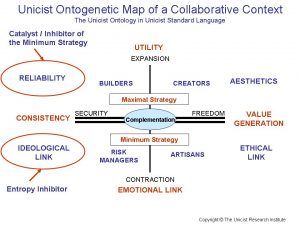 The time saving and productivity increase is significant when the conditions for virtual collaboration are given. It allows providing full synchronicity with the needs of customers and clients.
The time saving and productivity increase is significant when the conditions for virtual collaboration are given. It allows providing full synchronicity with the needs of customers and clients.
But there are several requirements for virtual collaboration to be implemented:
- Virtual collaboration needs transparency of work become part of the culture of an organization.
- It needs reliability systems that monitor work processes.
- It requires customer orientation that fosters fulfillment, synchronicity and reliability.
- Personal roles need to be complemented by quality assurance processes to ensure results.
If you want to access more information about this study please contact n.i.brown@unicist.org
Unicist Press Committee
NOTE: The Unicist Research Institute was the pioneer in complexity science research and became a private global decentralized leading research organization in the field of human adaptive systems. http://www.unicist.org









